Environmental Sustainability Report: Workplace Procedures and Policies
VerifiedAdded on 2020/05/01
|16
|2600
|63
Report
AI Summary
This report on sustainability encompasses various aspects of environmental management and corporate responsibility. Part 1 analyzes workplace procedures, resource consumption, and environmental hazards, including the impact of work activities on air and water quality. Part 2 delves into the role of the New South Wales Environment Protection Authority and the Environmental Sustainability Policy of 2015. It differentiates between greenwashing and green marketing, investigates consumer protection, and assesses the effectiveness of carbon offset programs. The report also explores methods for community and shareholder reporting, defines sustainability and its three pillars, explains carbon trading, provides examples of businesses losing their ecological footprint, and discusses the purpose of green office programs in Australia, along with the benefits of sustainability.

Running head: SUSTAINABILITY
Sustainability
Name of Student
Name of University
Author Note
Sustainability
Name of Student
Name of University
Author Note
Paraphrase This Document
Need a fresh take? Get an instant paraphrase of this document with our AI Paraphraser

1
SUSTAINABILITY
Table of Contents
PART-1......................................................................................................................................2
Activity 1................................................................................................................................2
Activity 2................................................................................................................................3
Activity 3................................................................................................................................4
Activity 4................................................................................................................................4
PART-2......................................................................................................................................7
1. Researching agency and policies of state...........................................................................7
2..............................................................................................................................................8
i. Differentiating between greenwashing and green marketing..............................................8
ii. Investigating whether Australian consumers protected from misleading..........................8
3..............................................................................................................................................9
i. Effectiveness of carbon offset programme..........................................................................9
ii. Finding ways to report to community and shareholders....................................................9
4. Defining sustainability and its three pillars......................................................................10
5. Explaining carbon trading................................................................................................10
6. Providing examples regarding business losing ecological footprint................................11
7. Purpose of green office programme in Australia.............................................................11
8. Providing examples of benefits of sustainability..............................................................12
Reference..................................................................................................................................13
SUSTAINABILITY
Table of Contents
PART-1......................................................................................................................................2
Activity 1................................................................................................................................2
Activity 2................................................................................................................................3
Activity 3................................................................................................................................4
Activity 4................................................................................................................................4
PART-2......................................................................................................................................7
1. Researching agency and policies of state...........................................................................7
2..............................................................................................................................................8
i. Differentiating between greenwashing and green marketing..............................................8
ii. Investigating whether Australian consumers protected from misleading..........................8
3..............................................................................................................................................9
i. Effectiveness of carbon offset programme..........................................................................9
ii. Finding ways to report to community and shareholders....................................................9
4. Defining sustainability and its three pillars......................................................................10
5. Explaining carbon trading................................................................................................10
6. Providing examples regarding business losing ecological footprint................................11
7. Purpose of green office programme in Australia.............................................................11
8. Providing examples of benefits of sustainability..............................................................12
Reference..................................................................................................................................13

2
SUSTAINABILITY
SUSTAINABILITY
⊘ This is a preview!⊘
Do you want full access?
Subscribe today to unlock all pages.

Trusted by 1+ million students worldwide
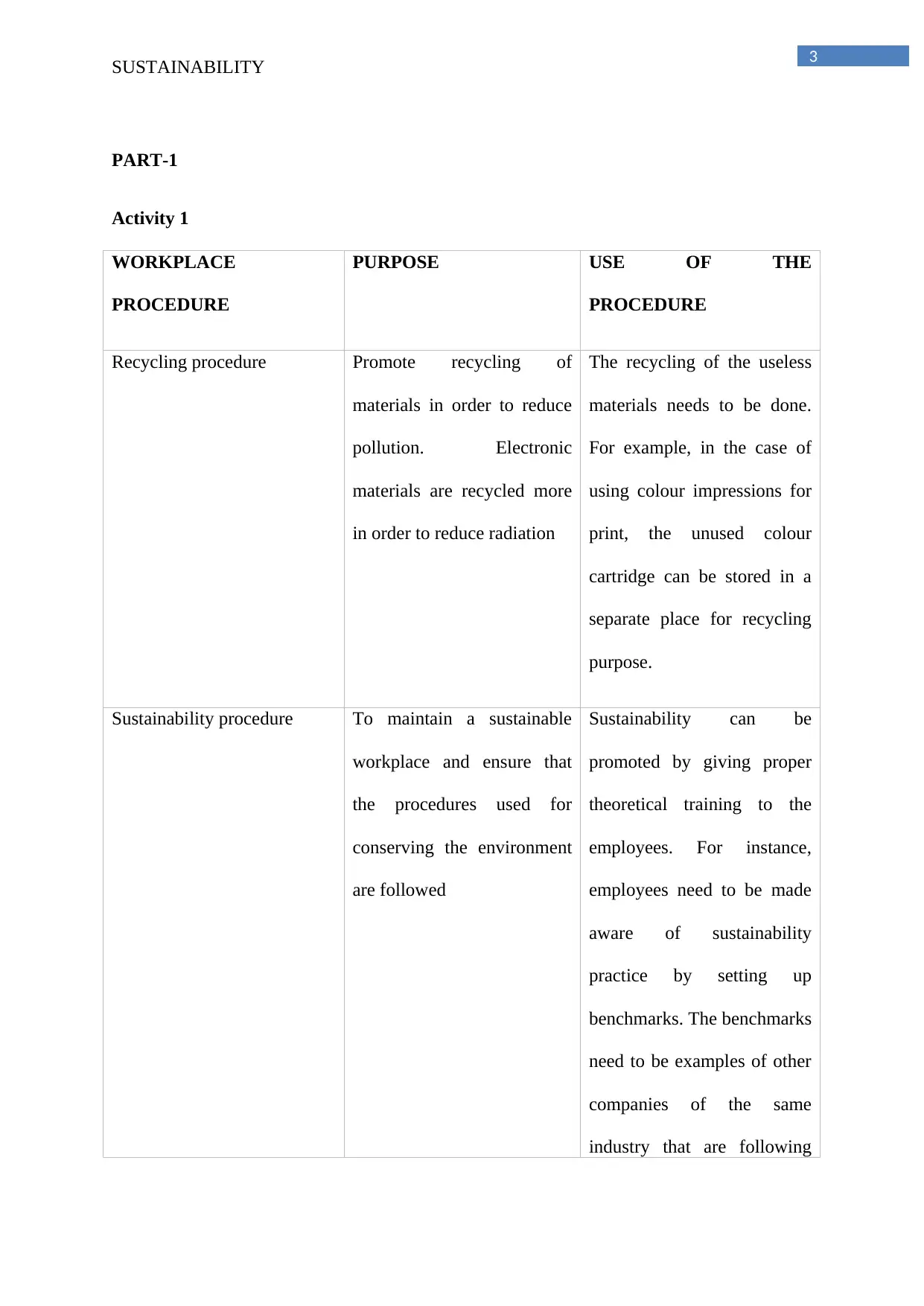
3
SUSTAINABILITY
PART-1
Activity 1
WORKPLACE
PROCEDURE
PURPOSE USE OF THE
PROCEDURE
Recycling procedure Promote recycling of
materials in order to reduce
pollution. Electronic
materials are recycled more
in order to reduce radiation
The recycling of the useless
materials needs to be done.
For example, in the case of
using colour impressions for
print, the unused colour
cartridge can be stored in a
separate place for recycling
purpose.
Sustainability procedure To maintain a sustainable
workplace and ensure that
the procedures used for
conserving the environment
are followed
Sustainability can be
promoted by giving proper
theoretical training to the
employees. For instance,
employees need to be made
aware of sustainability
practice by setting up
benchmarks. The benchmarks
need to be examples of other
companies of the same
industry that are following
SUSTAINABILITY
PART-1
Activity 1
WORKPLACE
PROCEDURE
PURPOSE USE OF THE
PROCEDURE
Recycling procedure Promote recycling of
materials in order to reduce
pollution. Electronic
materials are recycled more
in order to reduce radiation
The recycling of the useless
materials needs to be done.
For example, in the case of
using colour impressions for
print, the unused colour
cartridge can be stored in a
separate place for recycling
purpose.
Sustainability procedure To maintain a sustainable
workplace and ensure that
the procedures used for
conserving the environment
are followed
Sustainability can be
promoted by giving proper
theoretical training to the
employees. For instance,
employees need to be made
aware of sustainability
practice by setting up
benchmarks. The benchmarks
need to be examples of other
companies of the same
industry that are following
Paraphrase This Document
Need a fresh take? Get an instant paraphrase of this document with our AI Paraphraser
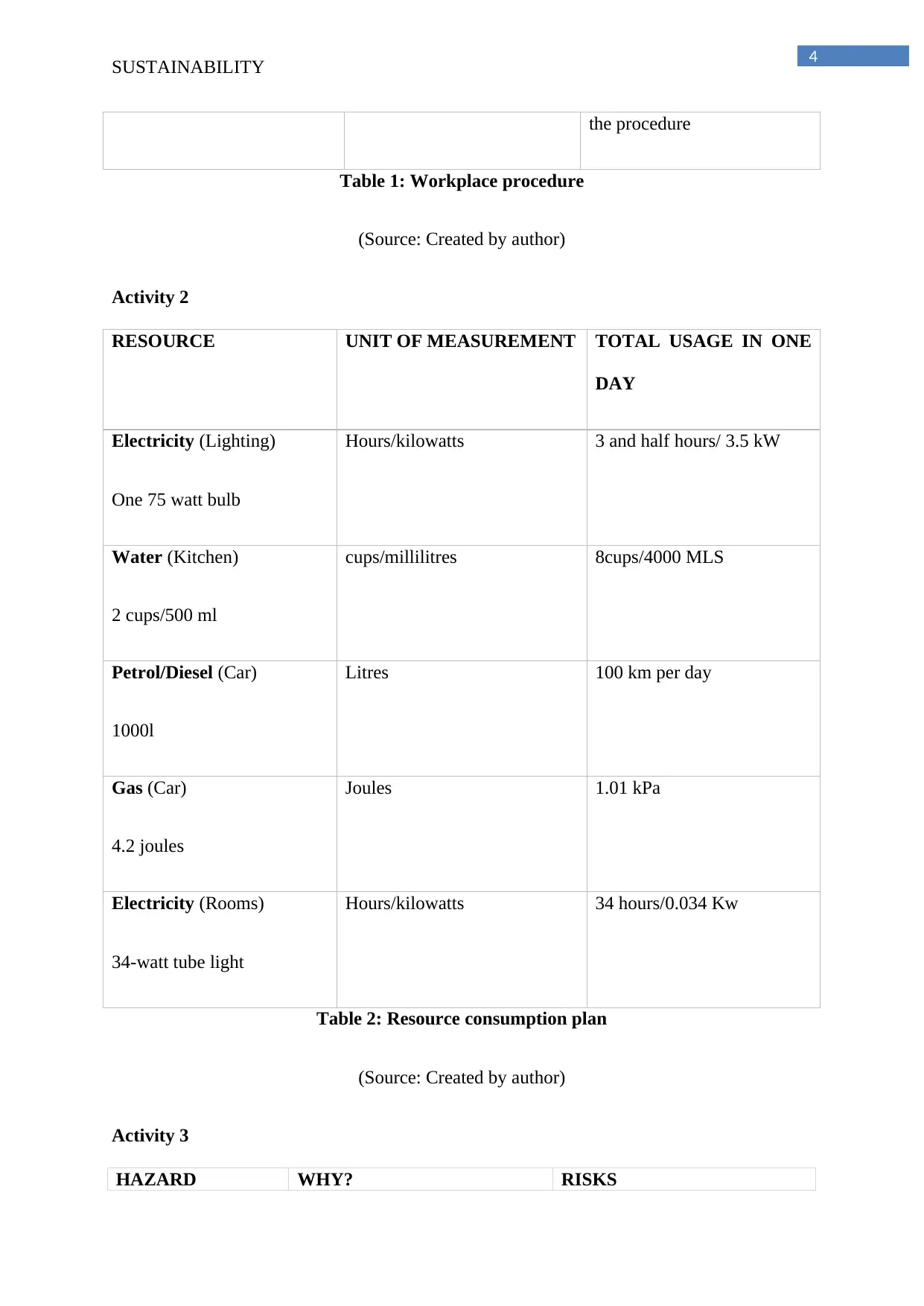
4
SUSTAINABILITY
the procedure
Table 1: Workplace procedure
(Source: Created by author)
Activity 2
RESOURCE UNIT OF MEASUREMENT TOTAL USAGE IN ONE
DAY
Electricity (Lighting)
One 75 watt bulb
Hours/kilowatts 3 and half hours/ 3.5 kW
Water (Kitchen)
2 cups/500 ml
cups/millilitres 8cups/4000 MLS
Petrol/Diesel (Car)
1000l
Litres 100 km per day
Gas (Car)
4.2 joules
Joules 1.01 kPa
Electricity (Rooms)
34-watt tube light
Hours/kilowatts 34 hours/0.034 Kw
Table 2: Resource consumption plan
(Source: Created by author)
Activity 3
HAZARD WHY? RISKS
SUSTAINABILITY
the procedure
Table 1: Workplace procedure
(Source: Created by author)
Activity 2
RESOURCE UNIT OF MEASUREMENT TOTAL USAGE IN ONE
DAY
Electricity (Lighting)
One 75 watt bulb
Hours/kilowatts 3 and half hours/ 3.5 kW
Water (Kitchen)
2 cups/500 ml
cups/millilitres 8cups/4000 MLS
Petrol/Diesel (Car)
1000l
Litres 100 km per day
Gas (Car)
4.2 joules
Joules 1.01 kPa
Electricity (Rooms)
34-watt tube light
Hours/kilowatts 34 hours/0.034 Kw
Table 2: Resource consumption plan
(Source: Created by author)
Activity 3
HAZARD WHY? RISKS
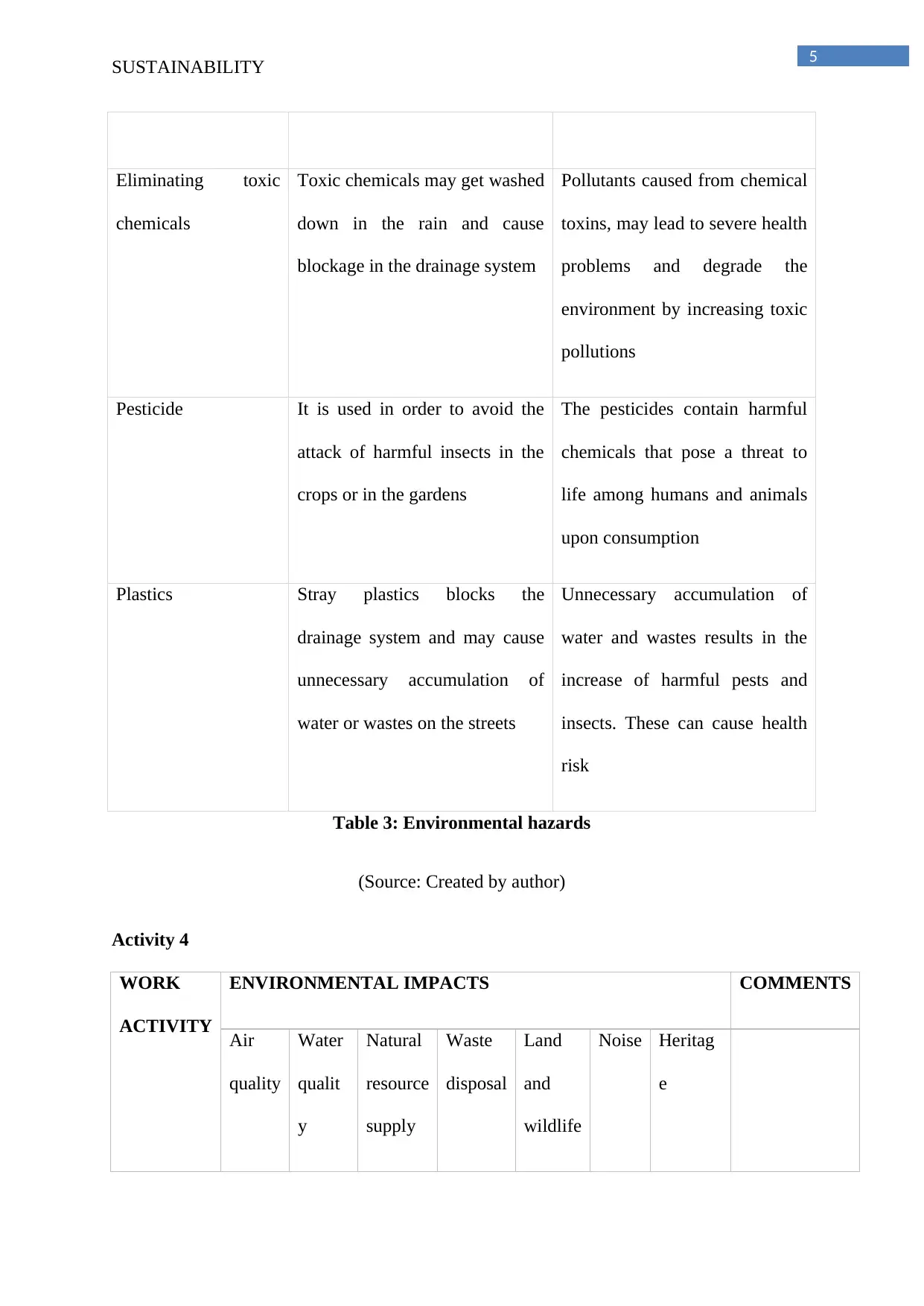
5
SUSTAINABILITY
Eliminating toxic
chemicals
Toxic chemicals may get washed
down in the rain and cause
blockage in the drainage system
Pollutants caused from chemical
toxins, may lead to severe health
problems and degrade the
environment by increasing toxic
pollutions
Pesticide It is used in order to avoid the
attack of harmful insects in the
crops or in the gardens
The pesticides contain harmful
chemicals that pose a threat to
life among humans and animals
upon consumption
Plastics Stray plastics blocks the
drainage system and may cause
unnecessary accumulation of
water or wastes on the streets
Unnecessary accumulation of
water and wastes results in the
increase of harmful pests and
insects. These can cause health
risk
Table 3: Environmental hazards
(Source: Created by author)
Activity 4
WORK
ACTIVITY
ENVIRONMENTAL IMPACTS COMMENTS
Air
quality
Water
qualit
y
Natural
resource
supply
Waste
disposal
Land
and
wildlife
Noise Heritag
e
SUSTAINABILITY
Eliminating toxic
chemicals
Toxic chemicals may get washed
down in the rain and cause
blockage in the drainage system
Pollutants caused from chemical
toxins, may lead to severe health
problems and degrade the
environment by increasing toxic
pollutions
Pesticide It is used in order to avoid the
attack of harmful insects in the
crops or in the gardens
The pesticides contain harmful
chemicals that pose a threat to
life among humans and animals
upon consumption
Plastics Stray plastics blocks the
drainage system and may cause
unnecessary accumulation of
water or wastes on the streets
Unnecessary accumulation of
water and wastes results in the
increase of harmful pests and
insects. These can cause health
risk
Table 3: Environmental hazards
(Source: Created by author)
Activity 4
WORK
ACTIVITY
ENVIRONMENTAL IMPACTS COMMENTS
Air
quality
Water
qualit
y
Natural
resource
supply
Waste
disposal
Land
and
wildlife
Noise Heritag
e
⊘ This is a preview!⊘
Do you want full access?
Subscribe today to unlock all pages.

Trusted by 1+ million students worldwide
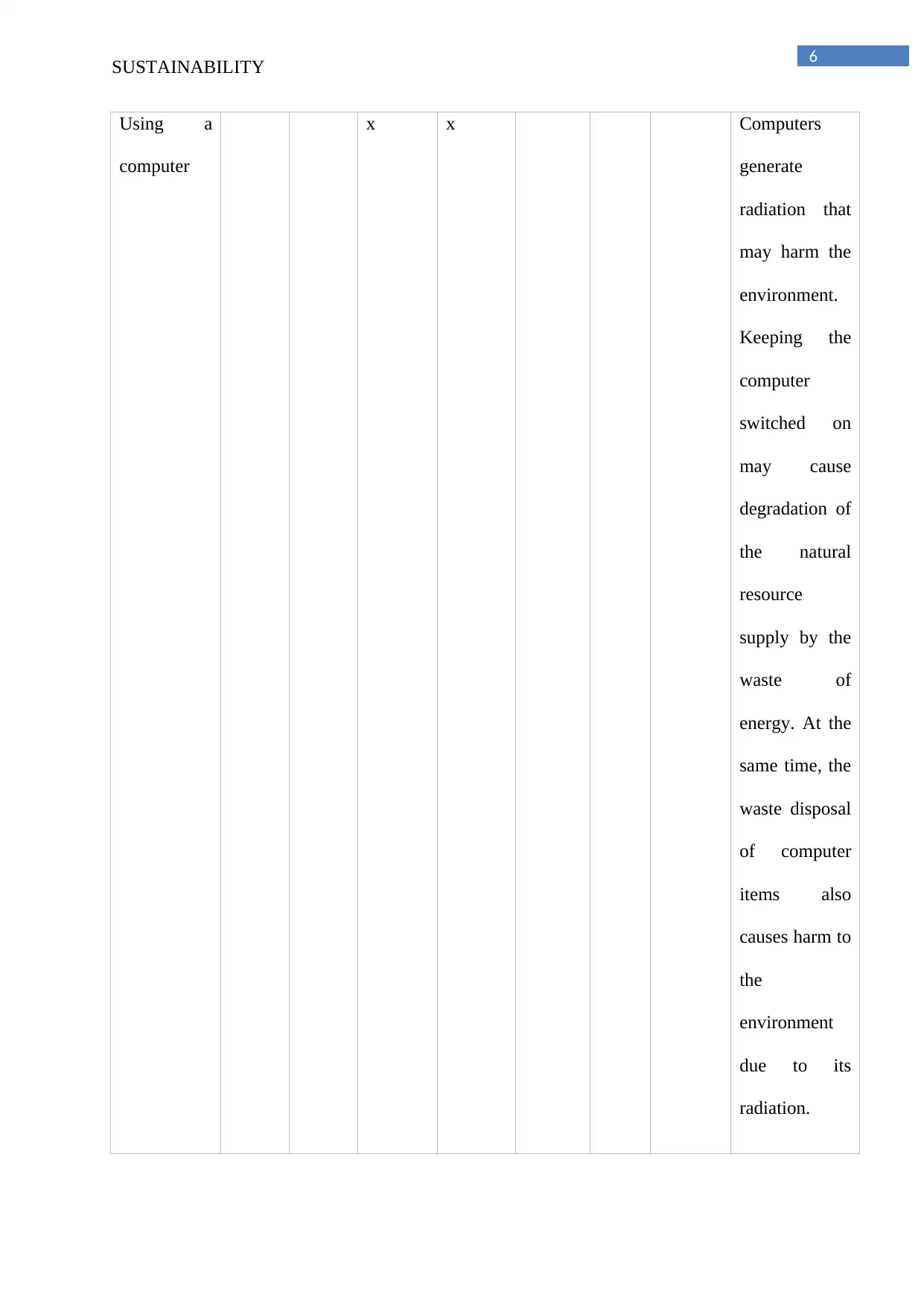
6
SUSTAINABILITY
Using a
computer
x x Computers
generate
radiation that
may harm the
environment.
Keeping the
computer
switched on
may cause
degradation of
the natural
resource
supply by the
waste of
energy. At the
same time, the
waste disposal
of computer
items also
causes harm to
the
environment
due to its
radiation.
SUSTAINABILITY
Using a
computer
x x Computers
generate
radiation that
may harm the
environment.
Keeping the
computer
switched on
may cause
degradation of
the natural
resource
supply by the
waste of
energy. At the
same time, the
waste disposal
of computer
items also
causes harm to
the
environment
due to its
radiation.
Paraphrase This Document
Need a fresh take? Get an instant paraphrase of this document with our AI Paraphraser
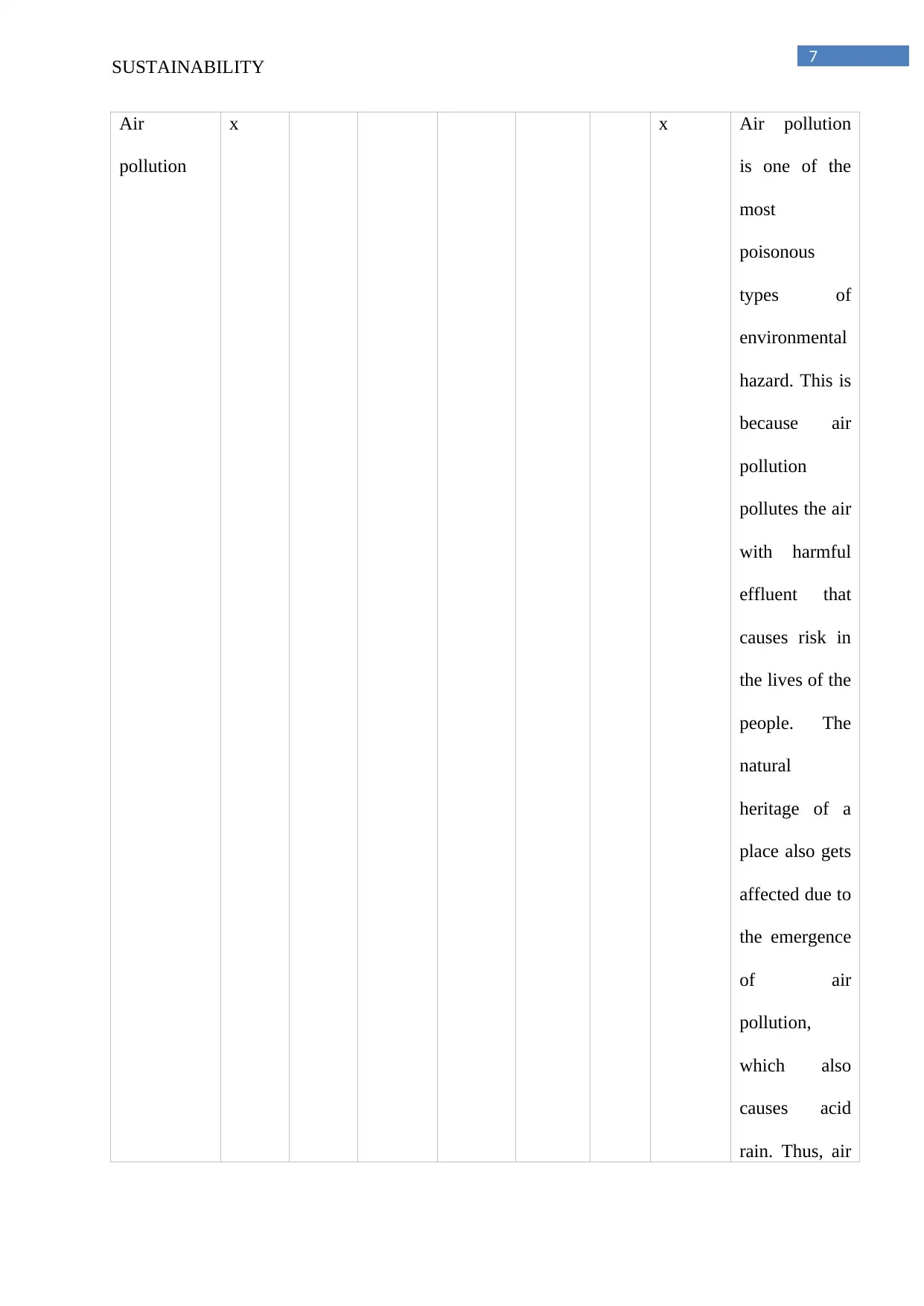
7
SUSTAINABILITY
Air
pollution
x x Air pollution
is one of the
most
poisonous
types of
environmental
hazard. This is
because air
pollution
pollutes the air
with harmful
effluent that
causes risk in
the lives of the
people. The
natural
heritage of a
place also gets
affected due to
the emergence
of air
pollution,
which also
causes acid
rain. Thus, air
SUSTAINABILITY
Air
pollution
x x Air pollution
is one of the
most
poisonous
types of
environmental
hazard. This is
because air
pollution
pollutes the air
with harmful
effluent that
causes risk in
the lives of the
people. The
natural
heritage of a
place also gets
affected due to
the emergence
of air
pollution,
which also
causes acid
rain. Thus, air
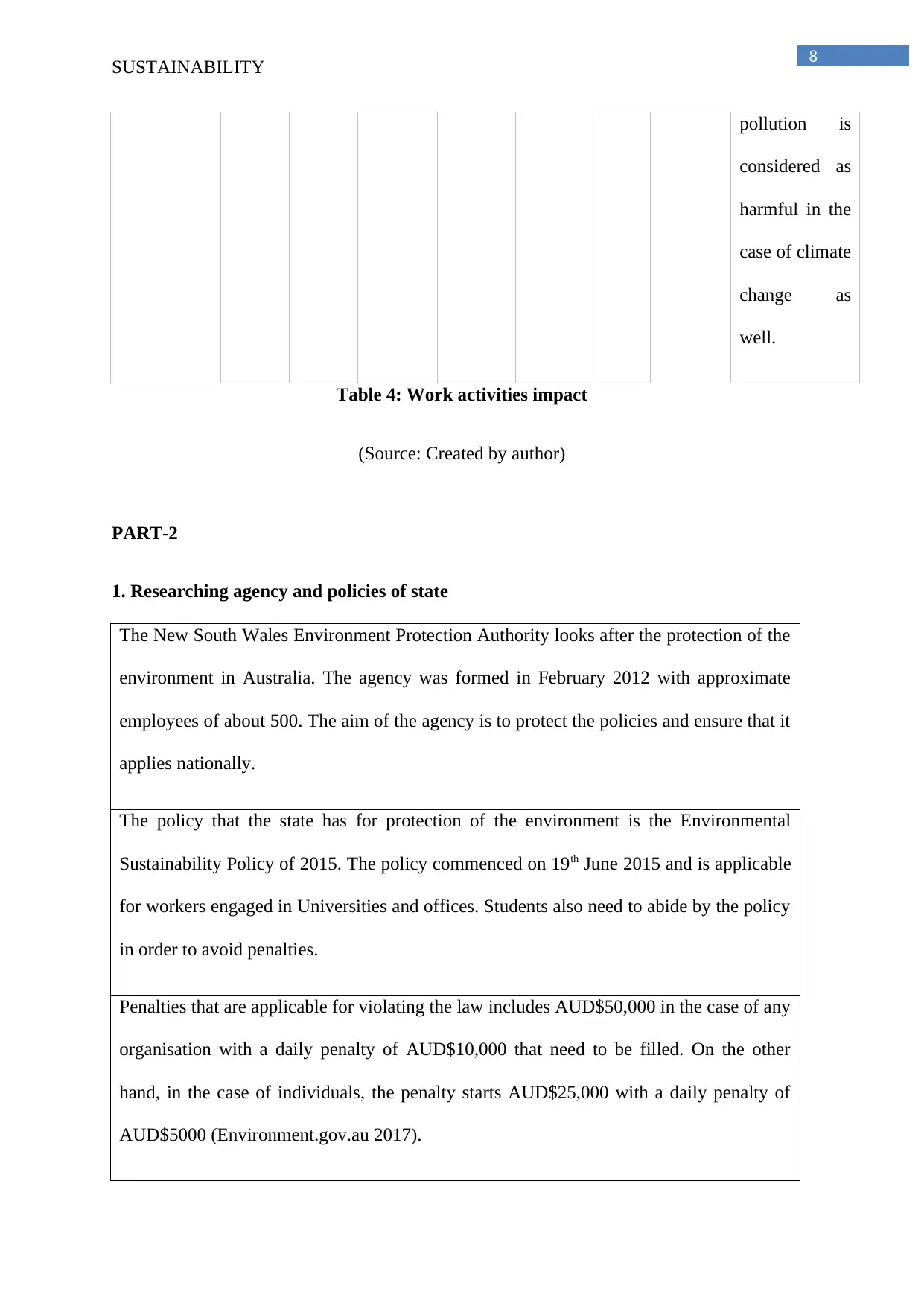
8
SUSTAINABILITY
pollution is
considered as
harmful in the
case of climate
change as
well.
Table 4: Work activities impact
(Source: Created by author)
PART-2
1. Researching agency and policies of state
The New South Wales Environment Protection Authority looks after the protection of the
environment in Australia. The agency was formed in February 2012 with approximate
employees of about 500. The aim of the agency is to protect the policies and ensure that it
applies nationally.
The policy that the state has for protection of the environment is the Environmental
Sustainability Policy of 2015. The policy commenced on 19th June 2015 and is applicable
for workers engaged in Universities and offices. Students also need to abide by the policy
in order to avoid penalties.
Penalties that are applicable for violating the law includes AUD$50,000 in the case of any
organisation with a daily penalty of AUD$10,000 that need to be filled. On the other
hand, in the case of individuals, the penalty starts AUD$25,000 with a daily penalty of
AUD$5000 (Environment.gov.au 2017).
SUSTAINABILITY
pollution is
considered as
harmful in the
case of climate
change as
well.
Table 4: Work activities impact
(Source: Created by author)
PART-2
1. Researching agency and policies of state
The New South Wales Environment Protection Authority looks after the protection of the
environment in Australia. The agency was formed in February 2012 with approximate
employees of about 500. The aim of the agency is to protect the policies and ensure that it
applies nationally.
The policy that the state has for protection of the environment is the Environmental
Sustainability Policy of 2015. The policy commenced on 19th June 2015 and is applicable
for workers engaged in Universities and offices. Students also need to abide by the policy
in order to avoid penalties.
Penalties that are applicable for violating the law includes AUD$50,000 in the case of any
organisation with a daily penalty of AUD$10,000 that need to be filled. On the other
hand, in the case of individuals, the penalty starts AUD$25,000 with a daily penalty of
AUD$5000 (Environment.gov.au 2017).
⊘ This is a preview!⊘
Do you want full access?
Subscribe today to unlock all pages.

Trusted by 1+ million students worldwide
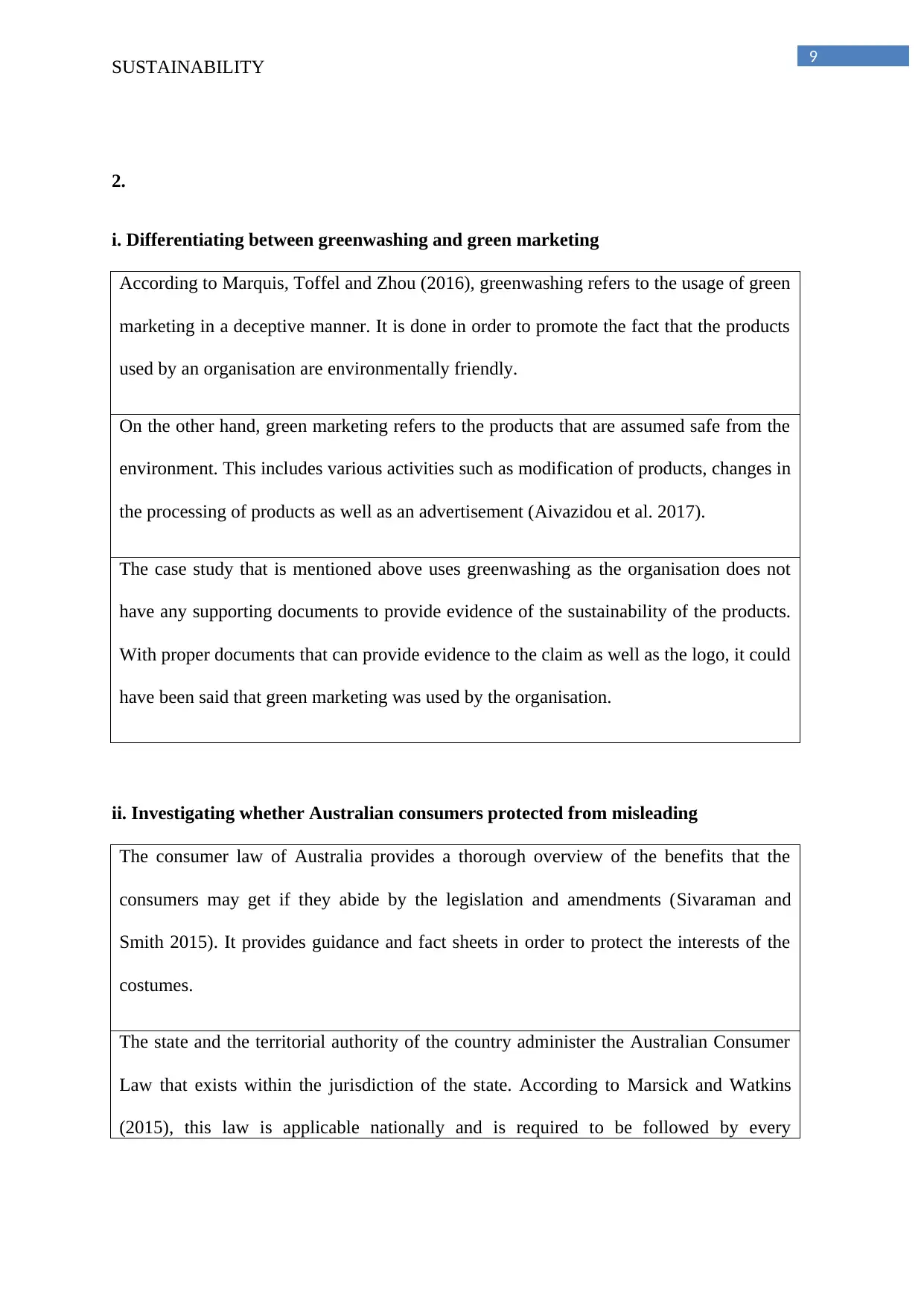
9
SUSTAINABILITY
2.
i. Differentiating between greenwashing and green marketing
According to Marquis, Toffel and Zhou (2016), greenwashing refers to the usage of green
marketing in a deceptive manner. It is done in order to promote the fact that the products
used by an organisation are environmentally friendly.
On the other hand, green marketing refers to the products that are assumed safe from the
environment. This includes various activities such as modification of products, changes in
the processing of products as well as an advertisement (Aivazidou et al. 2017).
The case study that is mentioned above uses greenwashing as the organisation does not
have any supporting documents to provide evidence of the sustainability of the products.
With proper documents that can provide evidence to the claim as well as the logo, it could
have been said that green marketing was used by the organisation.
ii. Investigating whether Australian consumers protected from misleading
The consumer law of Australia provides a thorough overview of the benefits that the
consumers may get if they abide by the legislation and amendments (Sivaraman and
Smith 2015). It provides guidance and fact sheets in order to protect the interests of the
costumes.
The state and the territorial authority of the country administer the Australian Consumer
Law that exists within the jurisdiction of the state. According to Marsick and Watkins
(2015), this law is applicable nationally and is required to be followed by every
SUSTAINABILITY
2.
i. Differentiating between greenwashing and green marketing
According to Marquis, Toffel and Zhou (2016), greenwashing refers to the usage of green
marketing in a deceptive manner. It is done in order to promote the fact that the products
used by an organisation are environmentally friendly.
On the other hand, green marketing refers to the products that are assumed safe from the
environment. This includes various activities such as modification of products, changes in
the processing of products as well as an advertisement (Aivazidou et al. 2017).
The case study that is mentioned above uses greenwashing as the organisation does not
have any supporting documents to provide evidence of the sustainability of the products.
With proper documents that can provide evidence to the claim as well as the logo, it could
have been said that green marketing was used by the organisation.
ii. Investigating whether Australian consumers protected from misleading
The consumer law of Australia provides a thorough overview of the benefits that the
consumers may get if they abide by the legislation and amendments (Sivaraman and
Smith 2015). It provides guidance and fact sheets in order to protect the interests of the
costumes.
The state and the territorial authority of the country administer the Australian Consumer
Law that exists within the jurisdiction of the state. According to Marsick and Watkins
(2015), this law is applicable nationally and is required to be followed by every
Paraphrase This Document
Need a fresh take? Get an instant paraphrase of this document with our AI Paraphraser
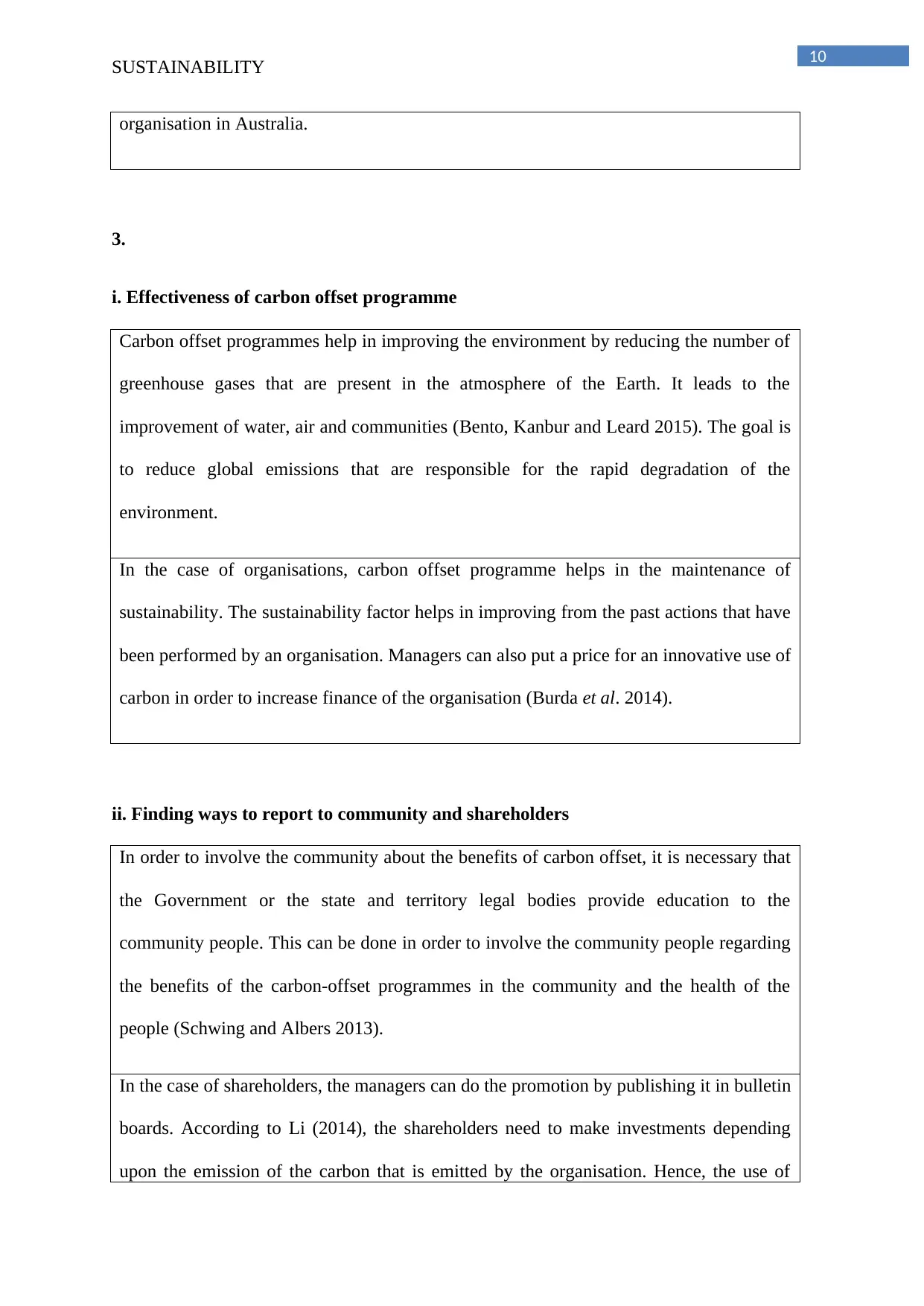
10
SUSTAINABILITY
organisation in Australia.
3.
i. Effectiveness of carbon offset programme
Carbon offset programmes help in improving the environment by reducing the number of
greenhouse gases that are present in the atmosphere of the Earth. It leads to the
improvement of water, air and communities (Bento, Kanbur and Leard 2015). The goal is
to reduce global emissions that are responsible for the rapid degradation of the
environment.
In the case of organisations, carbon offset programme helps in the maintenance of
sustainability. The sustainability factor helps in improving from the past actions that have
been performed by an organisation. Managers can also put a price for an innovative use of
carbon in order to increase finance of the organisation (Burda et al. 2014).
ii. Finding ways to report to community and shareholders
In order to involve the community about the benefits of carbon offset, it is necessary that
the Government or the state and territory legal bodies provide education to the
community people. This can be done in order to involve the community people regarding
the benefits of the carbon-offset programmes in the community and the health of the
people (Schwing and Albers 2013).
In the case of shareholders, the managers can do the promotion by publishing it in bulletin
boards. According to Li (2014), the shareholders need to make investments depending
upon the emission of the carbon that is emitted by the organisation. Hence, the use of
SUSTAINABILITY
organisation in Australia.
3.
i. Effectiveness of carbon offset programme
Carbon offset programmes help in improving the environment by reducing the number of
greenhouse gases that are present in the atmosphere of the Earth. It leads to the
improvement of water, air and communities (Bento, Kanbur and Leard 2015). The goal is
to reduce global emissions that are responsible for the rapid degradation of the
environment.
In the case of organisations, carbon offset programme helps in the maintenance of
sustainability. The sustainability factor helps in improving from the past actions that have
been performed by an organisation. Managers can also put a price for an innovative use of
carbon in order to increase finance of the organisation (Burda et al. 2014).
ii. Finding ways to report to community and shareholders
In order to involve the community about the benefits of carbon offset, it is necessary that
the Government or the state and territory legal bodies provide education to the
community people. This can be done in order to involve the community people regarding
the benefits of the carbon-offset programmes in the community and the health of the
people (Schwing and Albers 2013).
In the case of shareholders, the managers can do the promotion by publishing it in bulletin
boards. According to Li (2014), the shareholders need to make investments depending
upon the emission of the carbon that is emitted by the organisation. Hence, the use of
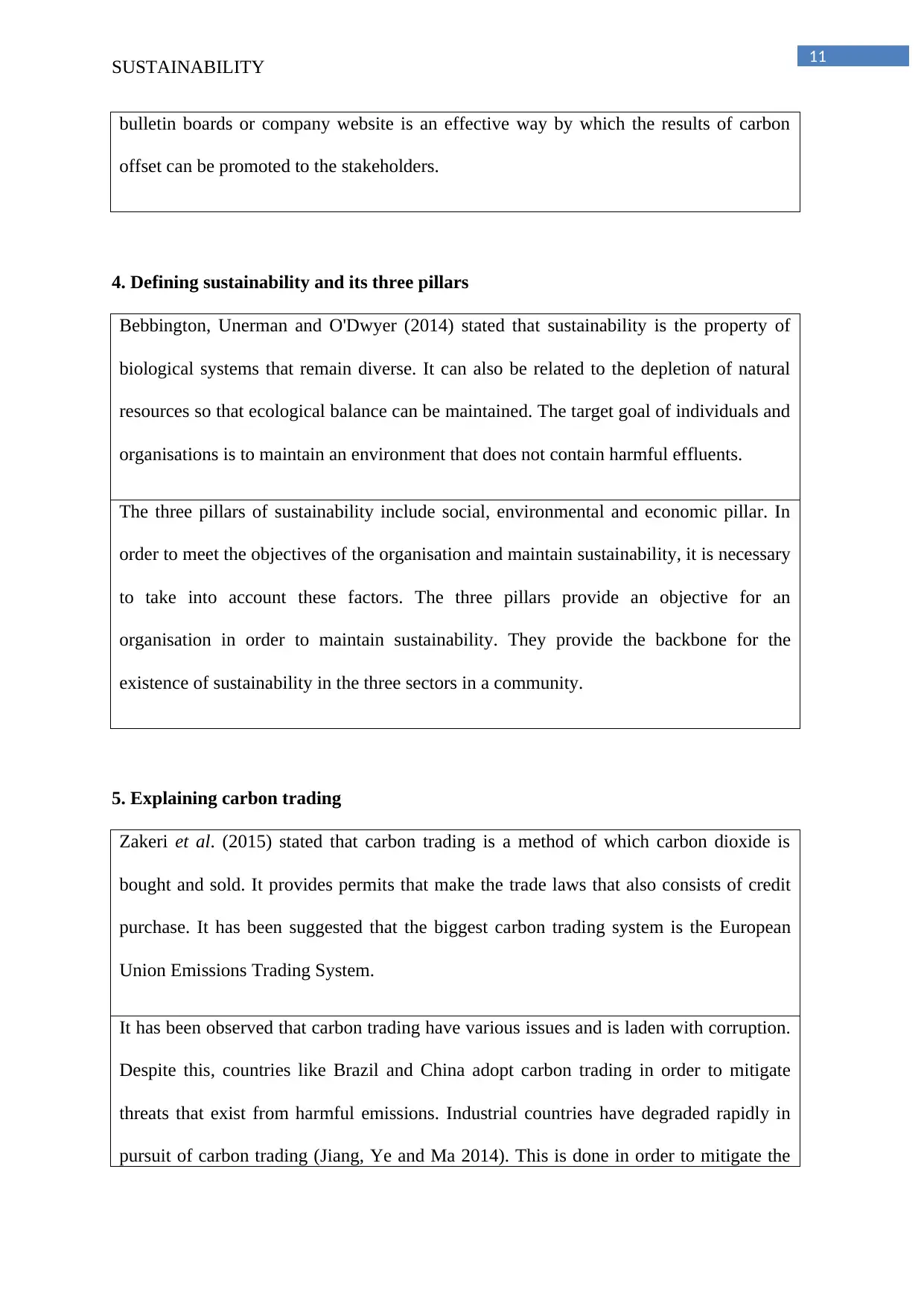
11
SUSTAINABILITY
bulletin boards or company website is an effective way by which the results of carbon
offset can be promoted to the stakeholders.
4. Defining sustainability and its three pillars
Bebbington, Unerman and O'Dwyer (2014) stated that sustainability is the property of
biological systems that remain diverse. It can also be related to the depletion of natural
resources so that ecological balance can be maintained. The target goal of individuals and
organisations is to maintain an environment that does not contain harmful effluents.
The three pillars of sustainability include social, environmental and economic pillar. In
order to meet the objectives of the organisation and maintain sustainability, it is necessary
to take into account these factors. The three pillars provide an objective for an
organisation in order to maintain sustainability. They provide the backbone for the
existence of sustainability in the three sectors in a community.
5. Explaining carbon trading
Zakeri et al. (2015) stated that carbon trading is a method of which carbon dioxide is
bought and sold. It provides permits that make the trade laws that also consists of credit
purchase. It has been suggested that the biggest carbon trading system is the European
Union Emissions Trading System.
It has been observed that carbon trading have various issues and is laden with corruption.
Despite this, countries like Brazil and China adopt carbon trading in order to mitigate
threats that exist from harmful emissions. Industrial countries have degraded rapidly in
pursuit of carbon trading (Jiang, Ye and Ma 2014). This is done in order to mitigate the
SUSTAINABILITY
bulletin boards or company website is an effective way by which the results of carbon
offset can be promoted to the stakeholders.
4. Defining sustainability and its three pillars
Bebbington, Unerman and O'Dwyer (2014) stated that sustainability is the property of
biological systems that remain diverse. It can also be related to the depletion of natural
resources so that ecological balance can be maintained. The target goal of individuals and
organisations is to maintain an environment that does not contain harmful effluents.
The three pillars of sustainability include social, environmental and economic pillar. In
order to meet the objectives of the organisation and maintain sustainability, it is necessary
to take into account these factors. The three pillars provide an objective for an
organisation in order to maintain sustainability. They provide the backbone for the
existence of sustainability in the three sectors in a community.
5. Explaining carbon trading
Zakeri et al. (2015) stated that carbon trading is a method of which carbon dioxide is
bought and sold. It provides permits that make the trade laws that also consists of credit
purchase. It has been suggested that the biggest carbon trading system is the European
Union Emissions Trading System.
It has been observed that carbon trading have various issues and is laden with corruption.
Despite this, countries like Brazil and China adopt carbon trading in order to mitigate
threats that exist from harmful emissions. Industrial countries have degraded rapidly in
pursuit of carbon trading (Jiang, Ye and Ma 2014). This is done in order to mitigate the
⊘ This is a preview!⊘
Do you want full access?
Subscribe today to unlock all pages.

Trusted by 1+ million students worldwide
1 out of 16
Your All-in-One AI-Powered Toolkit for Academic Success.
+13062052269
info@desklib.com
Available 24*7 on WhatsApp / Email
![[object Object]](/_next/static/media/star-bottom.7253800d.svg)
Unlock your academic potential
Copyright © 2020–2025 A2Z Services. All Rights Reserved. Developed and managed by ZUCOL.

